Join us Saturday, February 23, 1pm-5pm
For a Special Pre-Sale Exhibition & Reception
With Live Middle Eastern Music & Refreshments
On February 24, Material Culture will hold an important auction of fine art, antiques, carpets, and ethnographic arts under the title “Collector’s Eye.” A portion of the 300+ lots up for sale come from the art collection of the international healthcare company GlaxoSmithKline LLC, which holds many museum-quality pieces. The auction catalogue is available online through LiveAuctioneers, who will also facilitate live internet bidding at the time of the sale. The auction begins at 11 AM on Sunday, February 24, 2013. The auction preview will be open Thursday, February 21 and run through Saturday, February 23, 10am-5pm daily.
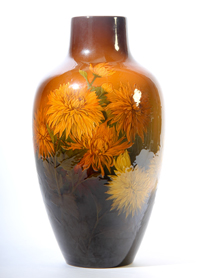
One of the exceptional pieces brought to auction by GlaxoSmithKline is a Rookwood Vase from 1900, decorated by Kitaro Shirayamandi with gorgeous chrysanthemums for Rookwood Pottery. Maria Longworth founded the Rookwood Pottery Company in 1880 in Cincinnati, Ohio, inspired by Japanese ceramics and under-glaze French pottery. Rookwood was the first American company to gain international admiration for ceramics from the United States, surprising detractors of American craft by winning the First Prize Gold Medal at the Paris Exposition Universelle in 1889. Japanese artist Kitaro Shiryamandi was invited to come to Ohio to create for the company in 1887, and the vase up at auction on February 24 is a spectacular example of his artistry. Gleaming with golden and cream chrysanthemums against a dark background, the hand-painted earthenware piece–produced in 1900– measures 18 inches by 9.5 inches, and is expected to fetch $10,000-$20,000.
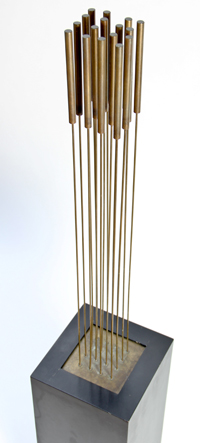
Work by renowned Italian-American sculptor and designer Harry Bertoia (1915-1978) also comes to auction from the GlaxoSmithKline collection. Bertoia studied the at the Art School of the Detroit Society of Arts and Crafts, earning a scholarship to the Cranbrook Academy of Art, where he studied under Bauhaus architect Walter Gropius, amongst others, and became friends with designers Florence Knoll and Charles and Ray Eames. He is perhaps most famous for designing the Diamond and Bird chairs for the Knoll furniture company, which became icons of modernist furniture, and for his sound sculpture. When he began exploring tonal sculpture in 1960, he was already well-known for his sculptures and installations, but his innovation in creating sculptures that generate their own otherworldly music has come to be his hallmark. A winner of awards from the American Institute of Architects and the American Academy of Letters, Bertoia has installations in public institutions around the country, and in the permanent collections of museums such as the Brooklyn Museum, the Philadelphia Museum of Art, the Cleveland Museum of Art, the Detroit Institute of Arts, the Honolulu Museum of Art, and the Hirshhorn Museum and Sculpture Garden and the Smithsonian American Art Museum, both in Washington D.C. The “Sounding Sculpture” at auction features sixteen rods of beryllium and copper, metals which were some of Bertoia’s favorites for tonal sculpture, set into a tall rectangular pedestal. He never made the same piece twice, enjoying the varied depth and timbre of differently-sized rods; this “Sounding Sculpture” measures approximately 30” height, on a 27” x 9“ x 9” pedestal, 57” overall. As is seen on some but not all of Bertoia’s sounding sculptures, the rods are capped with metal cylinders to accentuate the movement initiated by a hand or puff of air. Bertoia had renovated an old barn on his estate and assembled 100 sounding sculptures into the acoustically-perfected space, where he recorded eleven albums entitled “Sonambient,” featuring the sonorous, sometimes haunting, tones of his sculptures. His installation in the barn remains intact, but individual sounding sculptures have been in high demand at auction houses, and this “Sounding Sculpture” (made in the 1970’s) is valued at $10,000-$20,000. Also showcased at this sale is another of Bertoia’s sculptures, “Wheat Sheaves,” expected to fetch $5,000-$10,000. This stainless steel sculpture measures 45″ high on a 10″ x 10″ base.
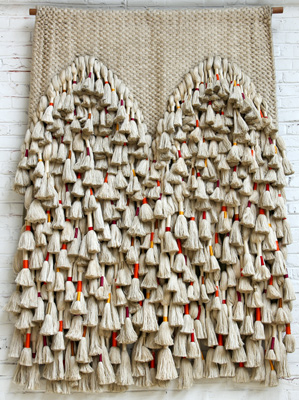
Another highlight of the GlaxoSmithKline holdings is Sheila Hicks’ “Double Prayer Rug,” made in 1970 at the Atelier des Grands Augustins in Paris. One of the world’s most preeminent fiber artists, Hicks (American, b. 1934) is influenced by the Bauhaus traditions of her painting instructor at Yale University, Josef Albers, and her study of Pre-Columbian textiles. Hicks relates in a 2004 interview with the Smithsonian Institution, “Textiles had been relegated to a secondary role in our society, to a material that was either functional or decorative. I wanted to give it another status and show what an artist can do with these incredible materials,” an aim she has unquestionably achieved. Her works, which often fuse abstract sculpture with weaving, are held in the permanent collections of museums such as the Metropolitan Museum of Art, the Museum of Modern Art, the Philadelphia Museum of Art, Centre Pompidou, Paris, and the Rhode Island School of Design Museum. In 2011, an important retrospective exhibited at the Addison Gallery in Andover, Massachusetts, the Mint Museum in Charlotte, North Carolina, and the Institute of Contemporary Art in Philadelphia. Measuring 80 x 60 inches. “Double Prayer Rug” plays with the tradition of textile, introducing woven sculptural elements. Hicks created a series of ‘Prayer Rugs,’ featuring, as this one does, a flat weave at top, from which wrapped pile projects into space in a cascade of tassels. The shape formed by the pile echoes the niche pattern of a classic prayer rug, and in the case of this unique “Double Prayer Rug,” a doubled niche. Constructed of silk, linen, cotton and gold thread, this innovative piece bears a pre-sale estimate of $10,000-$20,000.
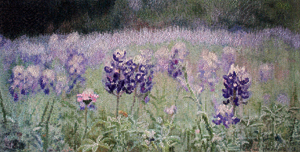
The collection includes another piece of significant fiber art, a tapestry entitled “Flower Field,” by Helena Hernmarck. Born in Stockholm, Sweden, in 1941, Hernmarck is one of the finest artists working in tapestry today. In contrast to Hicks’ abstract, multi-dimensional creations, Hernmarck’s tapestries are frequently pictorial, sometimes pulling three dimensions in a trompe l’oeil of a two-dimensonal weaving. Hernmarck studied her craft at Handarbetes Vanner Weaving School and the University College of Arts, Crafts and Design in Stockholm, and her work responds to Sweden’s rich textile tradition. Using Swedish yarn and Swedish looms, she creates large tapestries, frequently in relation to the public or private space for which they are commissioned, or to the natural world of the local community. Her work is in the collections of the Museum of Modern Art and the Metropolitan Museum of Art in New York, the Los Angeles County Museum of Art, and the National Museum of American Art in Washington, D.C. She has received numerous awards, including the American Institute of Architects Craftsmanship Medal (1973), and Sweden’s prestigious Prins Medal (1998). In 1996, she became a Fellow of the American Craft Council, and in 2000, she was elected the Swedish American of the year. Her piece at auction, “Flower Field,” depicts wildflowers of lilac and deep purple in a green field. Measuring 68 inches by 131 inches, this tapestry of silk and wool is valued at $5,000-$10,000.
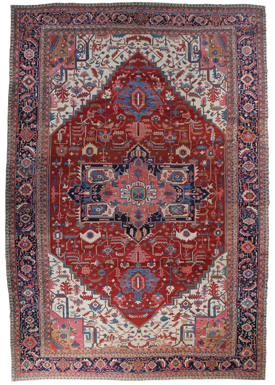
The auction will additionally showcase a number of truly spectacular carpets from private collections around the country and around the world. An antique Heriz carpet from Persia dates to the 19th century, its rich tones of burgundy, salmon, navy and sky blue well preserved, and the carpet’s overall condition excellent. Its central medallion, split-leaf decorations and guard-banded border are representative of classic Heriz designs, but what distinguishes the carpet is its extremely rare size, measuring 24 feet by 17 feet. Carpets of that length almost never exceed 14 feet in width, making wider rugs almost impossible for collectors to find. This Heriz carpet comes to the auction from a gentleman in North Carolina, and is expected to fetch $30,000-$40,000.
Another rare 19th century carpet at auction is a Turkish Oushak, which stands out for its spectacular condition, as near to mint as could be imagined. Woven in lustrous angora wool, the full pile carpet still has its original warp ends and vivid, playful colors. In fact, the carpet’s ochre, crimson and cornflower blue are far more lively and vibrant than the conventional palette of an Oushak; also notable is its inner border, which contains a band of Arabic script. This truly distinctive carpet, property of a gentleman in Dallas, Texas, measures 9 feet 3 inches by 12 feet 1 inch. It bears a presale estimate of $20,000-$30,000.

Other exceptional carpets include a Karagashli carpet, a top example of this type of Caucasian rug with its distinctive light sky blue color. The property of New York collector, this carpet measures 3’2″ by 4’10” and is valued at $8,000-$10,000. A consignor from Greece brings several fine carpets from auction, including an East Anatolian Kurd rug, approximately 150-200 years old, in very good condition for its age, it bears a presale estimate of $2,000-$4,000. Another from the same collector is an outstanding example of a true late 19th century Agra carpet, in wonderful full pile condition, still bearing brilliant, clear colors. This rug makes a compelling departure from the rigidly symmetrical designs of most Agras, where typically the patterns are read aloud to weavers; the main border of this carpet, in particular, exhibits its weavers’ improvisation and sense of play. Purchased in London in the 1970s, the carpet is expected to fetch $15,000-$25,000.
Material Culture welcomes all interested collectors and buyers to view the art, artifacts, and carpets in person at the auction preview in its facilities. The auction preview will be open Thursday, February 21 and run through Saturday, February 23, 10am-5pm daily. Interested parties not able to visit the exhibition gallery in person can also find a full catalogue of this auction online at liveauctioneers.com.
Join our Mailing List for updates.
